Principles of Logistics Management: Coca-Cola Company Analysis
VerifiedAdded on 2020/04/07
|9
|3061
|371
Report
AI Summary
This report provides a comprehensive analysis of the logistics management practices at the Coca-Cola Company. It begins by outlining the core principles of logistics and its role in the supply chain. The report then delves into the interfaces between the logistics department and other key functional areas within Coca-Cola, including marketing, production, and finance. A significant portion of the report is dedicated to examining the company's inventory management strategies, highlighting the use of technology and continuous review systems to optimize stock levels and minimize costs. Furthermore, the report details the four stages of Coca-Cola's order cycle, from order transmittal to delivery, providing insights into the efficiency and effectiveness of the company's processes. The report also offers recommendations for improvement, such as leveraging technology and enterprise resource planning systems. Overall, the report offers a detailed overview of Coca-Cola's supply chain and logistics operations.
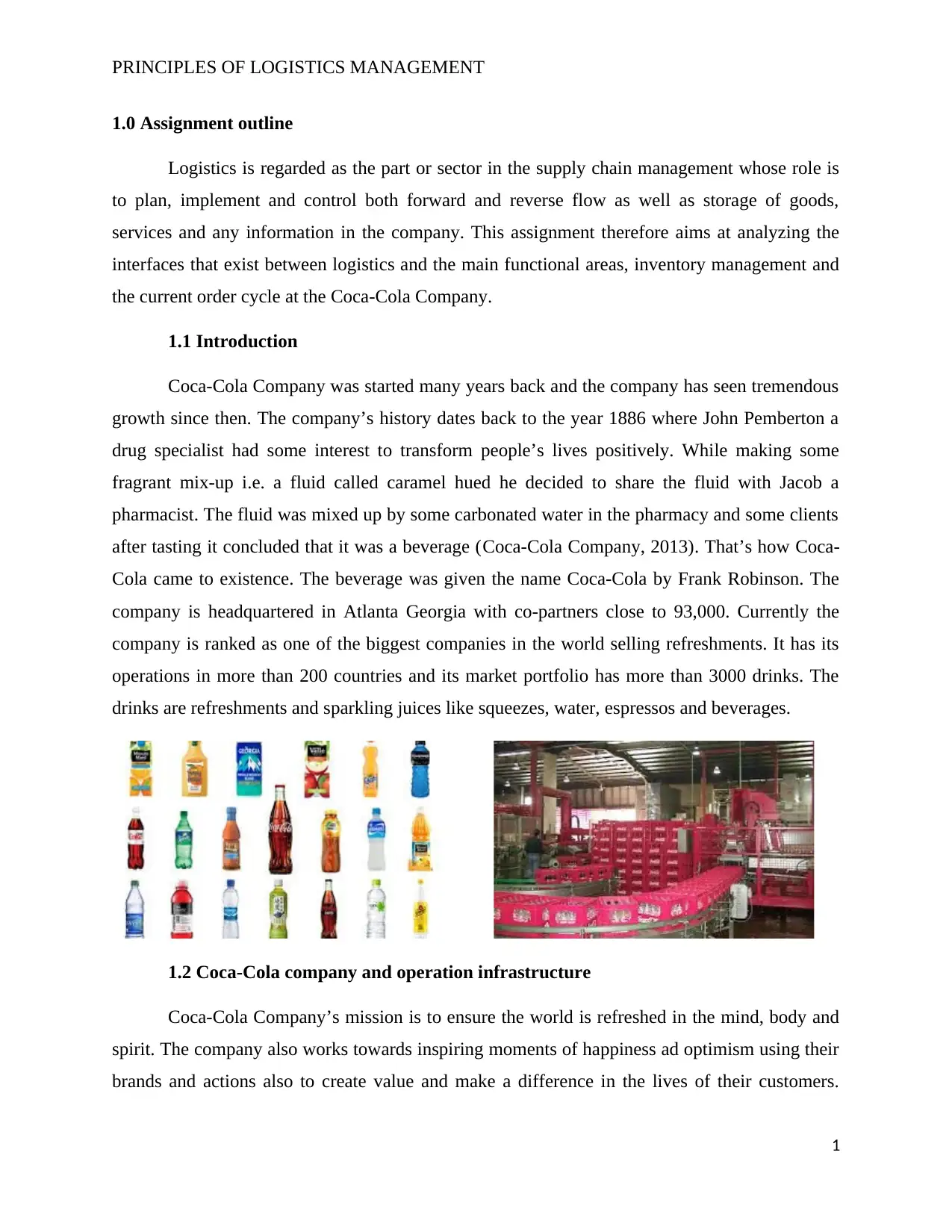
PRINCIPLES OF LOGISTICS MANAGEMENT
1.0 Assignment outline
Logistics is regarded as the part or sector in the supply chain management whose role is
to plan, implement and control both forward and reverse flow as well as storage of goods,
services and any information in the company. This assignment therefore aims at analyzing the
interfaces that exist between logistics and the main functional areas, inventory management and
the current order cycle at the Coca-Cola Company.
1.1 Introduction
Coca-Cola Company was started many years back and the company has seen tremendous
growth since then. The company’s history dates back to the year 1886 where John Pemberton a
drug specialist had some interest to transform people’s lives positively. While making some
fragrant mix-up i.e. a fluid called caramel hued he decided to share the fluid with Jacob a
pharmacist. The fluid was mixed up by some carbonated water in the pharmacy and some clients
after tasting it concluded that it was a beverage (Coca-Cola Company, 2013). That’s how Coca-
Cola came to existence. The beverage was given the name Coca-Cola by Frank Robinson. The
company is headquartered in Atlanta Georgia with co-partners close to 93,000. Currently the
company is ranked as one of the biggest companies in the world selling refreshments. It has its
operations in more than 200 countries and its market portfolio has more than 3000 drinks. The
drinks are refreshments and sparkling juices like squeezes, water, espressos and beverages.
1.2 Coca-Cola company and operation infrastructure
Coca-Cola Company’s mission is to ensure the world is refreshed in the mind, body and
spirit. The company also works towards inspiring moments of happiness ad optimism using their
brands and actions also to create value and make a difference in the lives of their customers.
1
1.0 Assignment outline
Logistics is regarded as the part or sector in the supply chain management whose role is
to plan, implement and control both forward and reverse flow as well as storage of goods,
services and any information in the company. This assignment therefore aims at analyzing the
interfaces that exist between logistics and the main functional areas, inventory management and
the current order cycle at the Coca-Cola Company.
1.1 Introduction
Coca-Cola Company was started many years back and the company has seen tremendous
growth since then. The company’s history dates back to the year 1886 where John Pemberton a
drug specialist had some interest to transform people’s lives positively. While making some
fragrant mix-up i.e. a fluid called caramel hued he decided to share the fluid with Jacob a
pharmacist. The fluid was mixed up by some carbonated water in the pharmacy and some clients
after tasting it concluded that it was a beverage (Coca-Cola Company, 2013). That’s how Coca-
Cola came to existence. The beverage was given the name Coca-Cola by Frank Robinson. The
company is headquartered in Atlanta Georgia with co-partners close to 93,000. Currently the
company is ranked as one of the biggest companies in the world selling refreshments. It has its
operations in more than 200 countries and its market portfolio has more than 3000 drinks. The
drinks are refreshments and sparkling juices like squeezes, water, espressos and beverages.
1.2 Coca-Cola company and operation infrastructure
Coca-Cola Company’s mission is to ensure the world is refreshed in the mind, body and
spirit. The company also works towards inspiring moments of happiness ad optimism using their
brands and actions also to create value and make a difference in the lives of their customers.
1
Paraphrase This Document
Need a fresh take? Get an instant paraphrase of this document with our AI Paraphraser
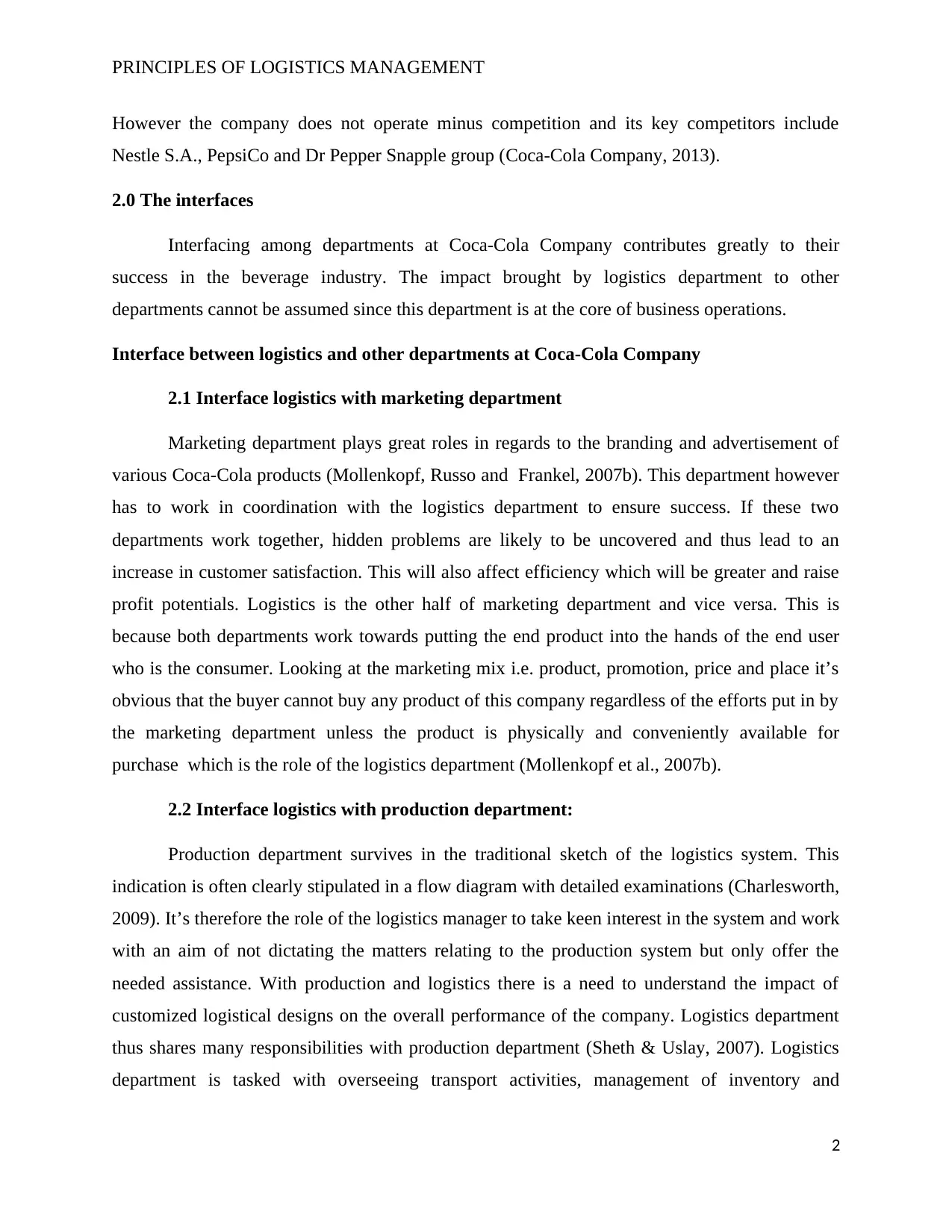
PRINCIPLES OF LOGISTICS MANAGEMENT
However the company does not operate minus competition and its key competitors include
Nestle S.A., PepsiCo and Dr Pepper Snapple group (Coca-Cola Company, 2013).
2.0 The interfaces
Interfacing among departments at Coca-Cola Company contributes greatly to their
success in the beverage industry. The impact brought by logistics department to other
departments cannot be assumed since this department is at the core of business operations.
Interface between logistics and other departments at Coca-Cola Company
2.1 Interface logistics with marketing department
Marketing department plays great roles in regards to the branding and advertisement of
various Coca-Cola products (Mollenkopf, Russo and Frankel, 2007b). This department however
has to work in coordination with the logistics department to ensure success. If these two
departments work together, hidden problems are likely to be uncovered and thus lead to an
increase in customer satisfaction. This will also affect efficiency which will be greater and raise
profit potentials. Logistics is the other half of marketing department and vice versa. This is
because both departments work towards putting the end product into the hands of the end user
who is the consumer. Looking at the marketing mix i.e. product, promotion, price and place it’s
obvious that the buyer cannot buy any product of this company regardless of the efforts put in by
the marketing department unless the product is physically and conveniently available for
purchase which is the role of the logistics department (Mollenkopf et al., 2007b).
2.2 Interface logistics with production department:
Production department survives in the traditional sketch of the logistics system. This
indication is often clearly stipulated in a flow diagram with detailed examinations (Charlesworth,
2009). It’s therefore the role of the logistics manager to take keen interest in the system and work
with an aim of not dictating the matters relating to the production system but only offer the
needed assistance. With production and logistics there is a need to understand the impact of
customized logistical designs on the overall performance of the company. Logistics department
thus shares many responsibilities with production department (Sheth & Uslay, 2007). Logistics
department is tasked with overseeing transport activities, management of inventory and
2
However the company does not operate minus competition and its key competitors include
Nestle S.A., PepsiCo and Dr Pepper Snapple group (Coca-Cola Company, 2013).
2.0 The interfaces
Interfacing among departments at Coca-Cola Company contributes greatly to their
success in the beverage industry. The impact brought by logistics department to other
departments cannot be assumed since this department is at the core of business operations.
Interface between logistics and other departments at Coca-Cola Company
2.1 Interface logistics with marketing department
Marketing department plays great roles in regards to the branding and advertisement of
various Coca-Cola products (Mollenkopf, Russo and Frankel, 2007b). This department however
has to work in coordination with the logistics department to ensure success. If these two
departments work together, hidden problems are likely to be uncovered and thus lead to an
increase in customer satisfaction. This will also affect efficiency which will be greater and raise
profit potentials. Logistics is the other half of marketing department and vice versa. This is
because both departments work towards putting the end product into the hands of the end user
who is the consumer. Looking at the marketing mix i.e. product, promotion, price and place it’s
obvious that the buyer cannot buy any product of this company regardless of the efforts put in by
the marketing department unless the product is physically and conveniently available for
purchase which is the role of the logistics department (Mollenkopf et al., 2007b).
2.2 Interface logistics with production department:
Production department survives in the traditional sketch of the logistics system. This
indication is often clearly stipulated in a flow diagram with detailed examinations (Charlesworth,
2009). It’s therefore the role of the logistics manager to take keen interest in the system and work
with an aim of not dictating the matters relating to the production system but only offer the
needed assistance. With production and logistics there is a need to understand the impact of
customized logistical designs on the overall performance of the company. Logistics department
thus shares many responsibilities with production department (Sheth & Uslay, 2007). Logistics
department is tasked with overseeing transport activities, management of inventory and
2
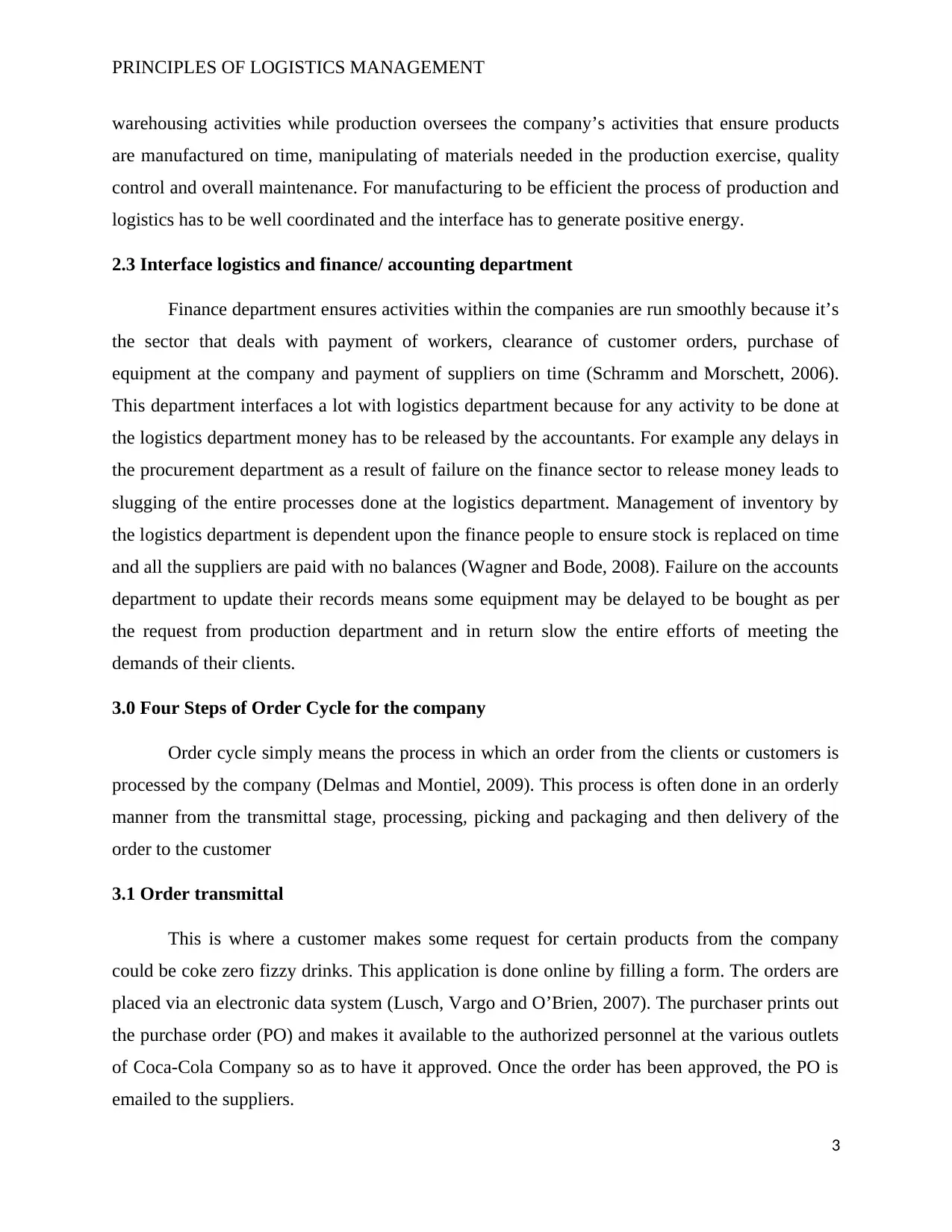
PRINCIPLES OF LOGISTICS MANAGEMENT
warehousing activities while production oversees the company’s activities that ensure products
are manufactured on time, manipulating of materials needed in the production exercise, quality
control and overall maintenance. For manufacturing to be efficient the process of production and
logistics has to be well coordinated and the interface has to generate positive energy.
2.3 Interface logistics and finance/ accounting department
Finance department ensures activities within the companies are run smoothly because it’s
the sector that deals with payment of workers, clearance of customer orders, purchase of
equipment at the company and payment of suppliers on time (Schramm and Morschett, 2006).
This department interfaces a lot with logistics department because for any activity to be done at
the logistics department money has to be released by the accountants. For example any delays in
the procurement department as a result of failure on the finance sector to release money leads to
slugging of the entire processes done at the logistics department. Management of inventory by
the logistics department is dependent upon the finance people to ensure stock is replaced on time
and all the suppliers are paid with no balances (Wagner and Bode, 2008). Failure on the accounts
department to update their records means some equipment may be delayed to be bought as per
the request from production department and in return slow the entire efforts of meeting the
demands of their clients.
3.0 Four Steps of Order Cycle for the company
Order cycle simply means the process in which an order from the clients or customers is
processed by the company (Delmas and Montiel, 2009). This process is often done in an orderly
manner from the transmittal stage, processing, picking and packaging and then delivery of the
order to the customer
3.1 Order transmittal
This is where a customer makes some request for certain products from the company
could be coke zero fizzy drinks. This application is done online by filling a form. The orders are
placed via an electronic data system (Lusch, Vargo and O’Brien, 2007). The purchaser prints out
the purchase order (PO) and makes it available to the authorized personnel at the various outlets
of Coca-Cola Company so as to have it approved. Once the order has been approved, the PO is
emailed to the suppliers.
3
warehousing activities while production oversees the company’s activities that ensure products
are manufactured on time, manipulating of materials needed in the production exercise, quality
control and overall maintenance. For manufacturing to be efficient the process of production and
logistics has to be well coordinated and the interface has to generate positive energy.
2.3 Interface logistics and finance/ accounting department
Finance department ensures activities within the companies are run smoothly because it’s
the sector that deals with payment of workers, clearance of customer orders, purchase of
equipment at the company and payment of suppliers on time (Schramm and Morschett, 2006).
This department interfaces a lot with logistics department because for any activity to be done at
the logistics department money has to be released by the accountants. For example any delays in
the procurement department as a result of failure on the finance sector to release money leads to
slugging of the entire processes done at the logistics department. Management of inventory by
the logistics department is dependent upon the finance people to ensure stock is replaced on time
and all the suppliers are paid with no balances (Wagner and Bode, 2008). Failure on the accounts
department to update their records means some equipment may be delayed to be bought as per
the request from production department and in return slow the entire efforts of meeting the
demands of their clients.
3.0 Four Steps of Order Cycle for the company
Order cycle simply means the process in which an order from the clients or customers is
processed by the company (Delmas and Montiel, 2009). This process is often done in an orderly
manner from the transmittal stage, processing, picking and packaging and then delivery of the
order to the customer
3.1 Order transmittal
This is where a customer makes some request for certain products from the company
could be coke zero fizzy drinks. This application is done online by filling a form. The orders are
placed via an electronic data system (Lusch, Vargo and O’Brien, 2007). The purchaser prints out
the purchase order (PO) and makes it available to the authorized personnel at the various outlets
of Coca-Cola Company so as to have it approved. Once the order has been approved, the PO is
emailed to the suppliers.
3
⊘ This is a preview!⊘
Do you want full access?
Subscribe today to unlock all pages.

Trusted by 1+ million students worldwide
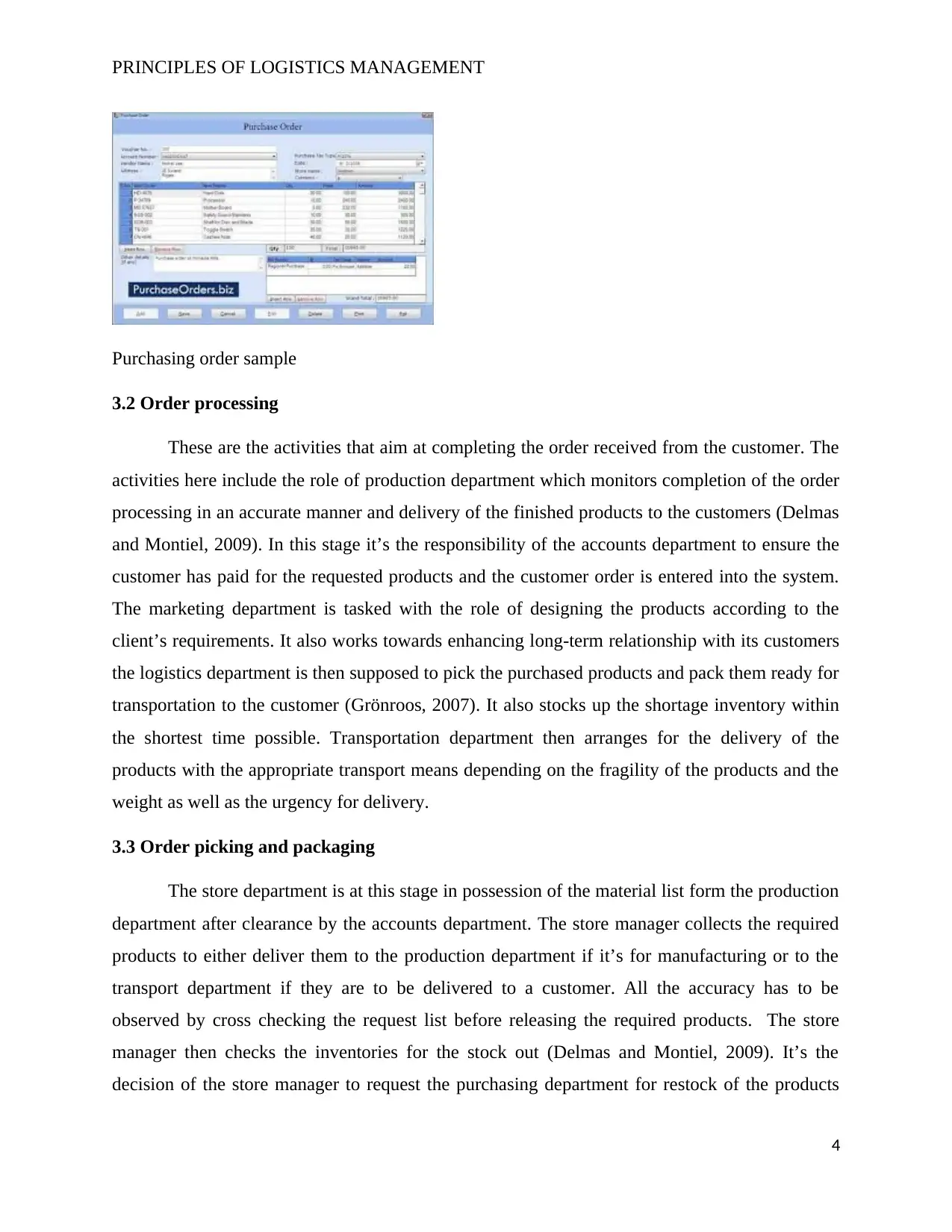
PRINCIPLES OF LOGISTICS MANAGEMENT
Purchasing order sample
3.2 Order processing
These are the activities that aim at completing the order received from the customer. The
activities here include the role of production department which monitors completion of the order
processing in an accurate manner and delivery of the finished products to the customers (Delmas
and Montiel, 2009). In this stage it’s the responsibility of the accounts department to ensure the
customer has paid for the requested products and the customer order is entered into the system.
The marketing department is tasked with the role of designing the products according to the
client’s requirements. It also works towards enhancing long-term relationship with its customers
the logistics department is then supposed to pick the purchased products and pack them ready for
transportation to the customer (Grönroos, 2007). It also stocks up the shortage inventory within
the shortest time possible. Transportation department then arranges for the delivery of the
products with the appropriate transport means depending on the fragility of the products and the
weight as well as the urgency for delivery.
3.3 Order picking and packaging
The store department is at this stage in possession of the material list form the production
department after clearance by the accounts department. The store manager collects the required
products to either deliver them to the production department if it’s for manufacturing or to the
transport department if they are to be delivered to a customer. All the accuracy has to be
observed by cross checking the request list before releasing the required products. The store
manager then checks the inventories for the stock out (Delmas and Montiel, 2009). It’s the
decision of the store manager to request the purchasing department for restock of the products
4
Purchasing order sample
3.2 Order processing
These are the activities that aim at completing the order received from the customer. The
activities here include the role of production department which monitors completion of the order
processing in an accurate manner and delivery of the finished products to the customers (Delmas
and Montiel, 2009). In this stage it’s the responsibility of the accounts department to ensure the
customer has paid for the requested products and the customer order is entered into the system.
The marketing department is tasked with the role of designing the products according to the
client’s requirements. It also works towards enhancing long-term relationship with its customers
the logistics department is then supposed to pick the purchased products and pack them ready for
transportation to the customer (Grönroos, 2007). It also stocks up the shortage inventory within
the shortest time possible. Transportation department then arranges for the delivery of the
products with the appropriate transport means depending on the fragility of the products and the
weight as well as the urgency for delivery.
3.3 Order picking and packaging
The store department is at this stage in possession of the material list form the production
department after clearance by the accounts department. The store manager collects the required
products to either deliver them to the production department if it’s for manufacturing or to the
transport department if they are to be delivered to a customer. All the accuracy has to be
observed by cross checking the request list before releasing the required products. The store
manager then checks the inventories for the stock out (Delmas and Montiel, 2009). It’s the
decision of the store manager to request the purchasing department for restock of the products
4
Paraphrase This Document
Need a fresh take? Get an instant paraphrase of this document with our AI Paraphraser
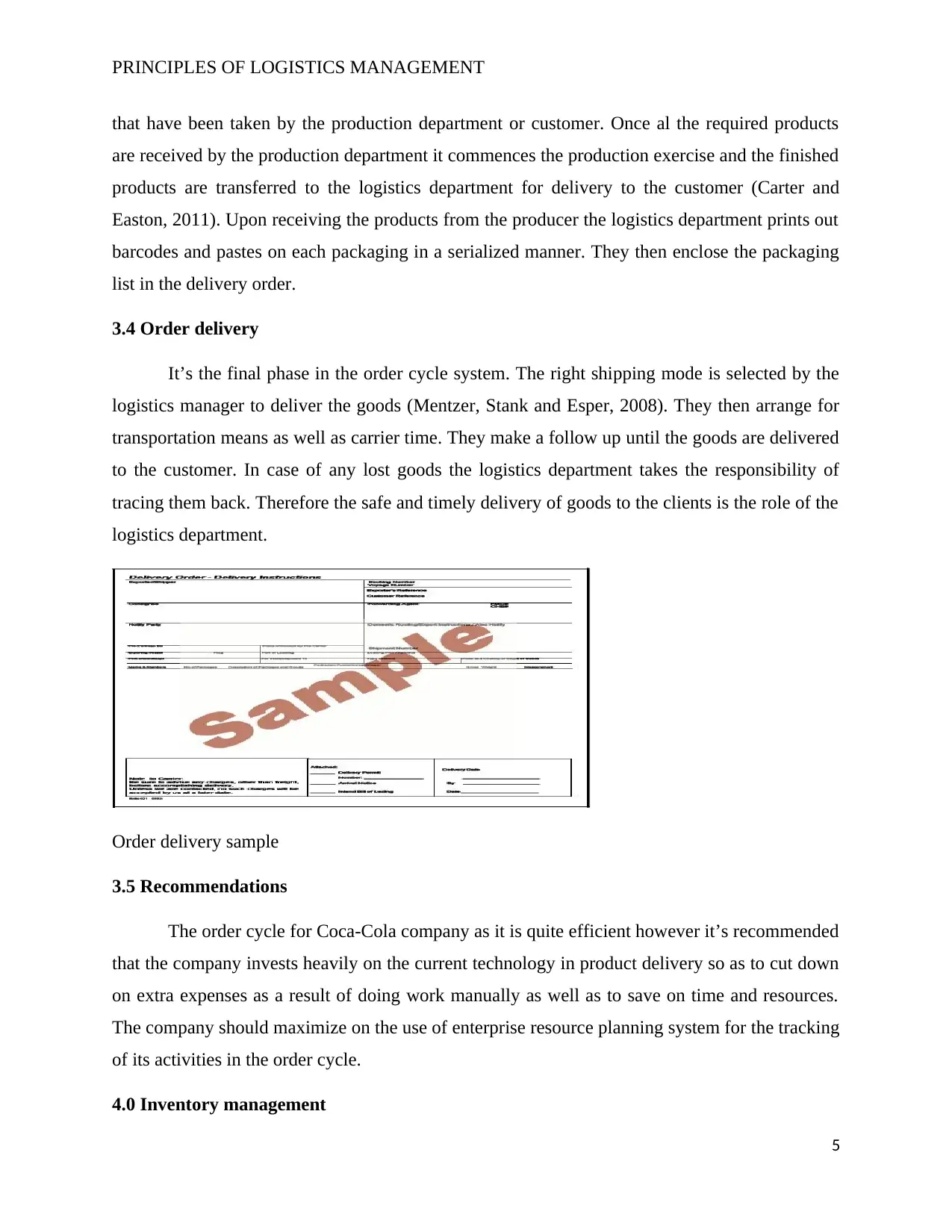
PRINCIPLES OF LOGISTICS MANAGEMENT
that have been taken by the production department or customer. Once al the required products
are received by the production department it commences the production exercise and the finished
products are transferred to the logistics department for delivery to the customer (Carter and
Easton, 2011). Upon receiving the products from the producer the logistics department prints out
barcodes and pastes on each packaging in a serialized manner. They then enclose the packaging
list in the delivery order.
3.4 Order delivery
It’s the final phase in the order cycle system. The right shipping mode is selected by the
logistics manager to deliver the goods (Mentzer, Stank and Esper, 2008). They then arrange for
transportation means as well as carrier time. They make a follow up until the goods are delivered
to the customer. In case of any lost goods the logistics department takes the responsibility of
tracing them back. Therefore the safe and timely delivery of goods to the clients is the role of the
logistics department.
Order delivery sample
3.5 Recommendations
The order cycle for Coca-Cola company as it is quite efficient however it’s recommended
that the company invests heavily on the current technology in product delivery so as to cut down
on extra expenses as a result of doing work manually as well as to save on time and resources.
The company should maximize on the use of enterprise resource planning system for the tracking
of its activities in the order cycle.
4.0 Inventory management
5
that have been taken by the production department or customer. Once al the required products
are received by the production department it commences the production exercise and the finished
products are transferred to the logistics department for delivery to the customer (Carter and
Easton, 2011). Upon receiving the products from the producer the logistics department prints out
barcodes and pastes on each packaging in a serialized manner. They then enclose the packaging
list in the delivery order.
3.4 Order delivery
It’s the final phase in the order cycle system. The right shipping mode is selected by the
logistics manager to deliver the goods (Mentzer, Stank and Esper, 2008). They then arrange for
transportation means as well as carrier time. They make a follow up until the goods are delivered
to the customer. In case of any lost goods the logistics department takes the responsibility of
tracing them back. Therefore the safe and timely delivery of goods to the clients is the role of the
logistics department.
Order delivery sample
3.5 Recommendations
The order cycle for Coca-Cola company as it is quite efficient however it’s recommended
that the company invests heavily on the current technology in product delivery so as to cut down
on extra expenses as a result of doing work manually as well as to save on time and resources.
The company should maximize on the use of enterprise resource planning system for the tracking
of its activities in the order cycle.
4.0 Inventory management
5
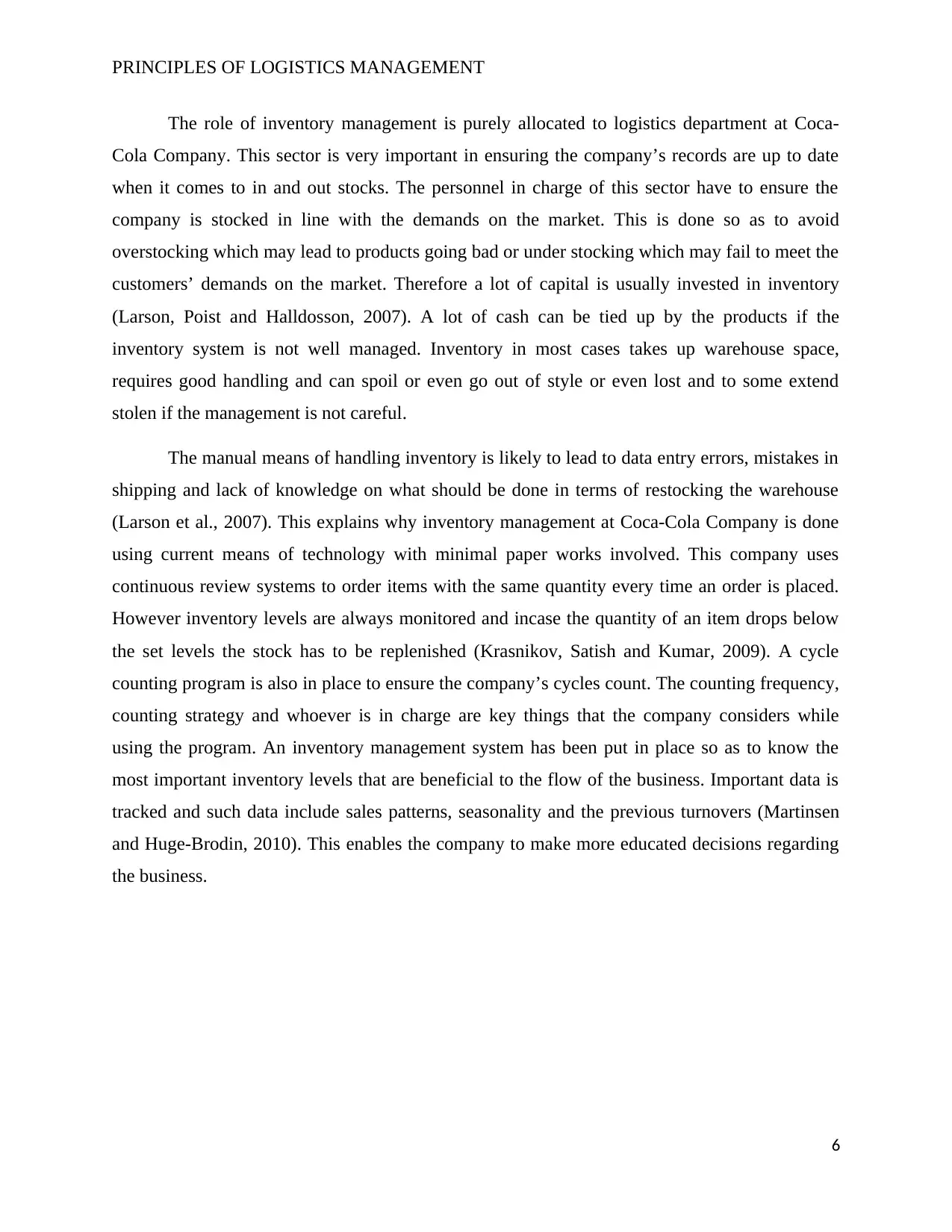
PRINCIPLES OF LOGISTICS MANAGEMENT
The role of inventory management is purely allocated to logistics department at Coca-
Cola Company. This sector is very important in ensuring the company’s records are up to date
when it comes to in and out stocks. The personnel in charge of this sector have to ensure the
company is stocked in line with the demands on the market. This is done so as to avoid
overstocking which may lead to products going bad or under stocking which may fail to meet the
customers’ demands on the market. Therefore a lot of capital is usually invested in inventory
(Larson, Poist and Halldosson, 2007). A lot of cash can be tied up by the products if the
inventory system is not well managed. Inventory in most cases takes up warehouse space,
requires good handling and can spoil or even go out of style or even lost and to some extend
stolen if the management is not careful.
The manual means of handling inventory is likely to lead to data entry errors, mistakes in
shipping and lack of knowledge on what should be done in terms of restocking the warehouse
(Larson et al., 2007). This explains why inventory management at Coca-Cola Company is done
using current means of technology with minimal paper works involved. This company uses
continuous review systems to order items with the same quantity every time an order is placed.
However inventory levels are always monitored and incase the quantity of an item drops below
the set levels the stock has to be replenished (Krasnikov, Satish and Kumar, 2009). A cycle
counting program is also in place to ensure the company’s cycles count. The counting frequency,
counting strategy and whoever is in charge are key things that the company considers while
using the program. An inventory management system has been put in place so as to know the
most important inventory levels that are beneficial to the flow of the business. Important data is
tracked and such data include sales patterns, seasonality and the previous turnovers (Martinsen
and Huge-Brodin, 2010). This enables the company to make more educated decisions regarding
the business.
6
The role of inventory management is purely allocated to logistics department at Coca-
Cola Company. This sector is very important in ensuring the company’s records are up to date
when it comes to in and out stocks. The personnel in charge of this sector have to ensure the
company is stocked in line with the demands on the market. This is done so as to avoid
overstocking which may lead to products going bad or under stocking which may fail to meet the
customers’ demands on the market. Therefore a lot of capital is usually invested in inventory
(Larson, Poist and Halldosson, 2007). A lot of cash can be tied up by the products if the
inventory system is not well managed. Inventory in most cases takes up warehouse space,
requires good handling and can spoil or even go out of style or even lost and to some extend
stolen if the management is not careful.
The manual means of handling inventory is likely to lead to data entry errors, mistakes in
shipping and lack of knowledge on what should be done in terms of restocking the warehouse
(Larson et al., 2007). This explains why inventory management at Coca-Cola Company is done
using current means of technology with minimal paper works involved. This company uses
continuous review systems to order items with the same quantity every time an order is placed.
However inventory levels are always monitored and incase the quantity of an item drops below
the set levels the stock has to be replenished (Krasnikov, Satish and Kumar, 2009). A cycle
counting program is also in place to ensure the company’s cycles count. The counting frequency,
counting strategy and whoever is in charge are key things that the company considers while
using the program. An inventory management system has been put in place so as to know the
most important inventory levels that are beneficial to the flow of the business. Important data is
tracked and such data include sales patterns, seasonality and the previous turnovers (Martinsen
and Huge-Brodin, 2010). This enables the company to make more educated decisions regarding
the business.
6
⊘ This is a preview!⊘
Do you want full access?
Subscribe today to unlock all pages.

Trusted by 1+ million students worldwide
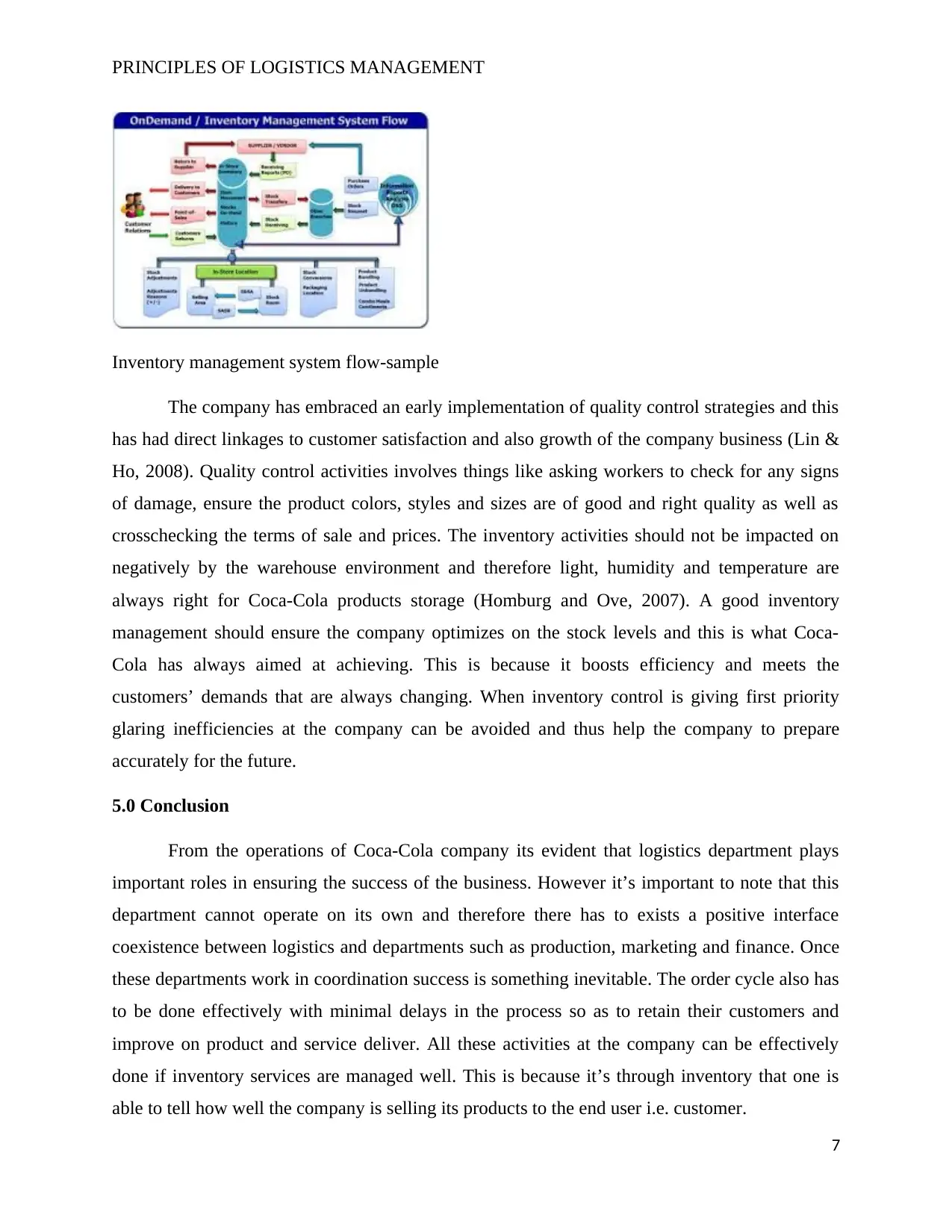
PRINCIPLES OF LOGISTICS MANAGEMENT
Inventory management system flow-sample
The company has embraced an early implementation of quality control strategies and this
has had direct linkages to customer satisfaction and also growth of the company business (Lin &
Ho, 2008). Quality control activities involves things like asking workers to check for any signs
of damage, ensure the product colors, styles and sizes are of good and right quality as well as
crosschecking the terms of sale and prices. The inventory activities should not be impacted on
negatively by the warehouse environment and therefore light, humidity and temperature are
always right for Coca-Cola products storage (Homburg and Ove, 2007). A good inventory
management should ensure the company optimizes on the stock levels and this is what Coca-
Cola has always aimed at achieving. This is because it boosts efficiency and meets the
customers’ demands that are always changing. When inventory control is giving first priority
glaring inefficiencies at the company can be avoided and thus help the company to prepare
accurately for the future.
5.0 Conclusion
From the operations of Coca-Cola company its evident that logistics department plays
important roles in ensuring the success of the business. However it’s important to note that this
department cannot operate on its own and therefore there has to exists a positive interface
coexistence between logistics and departments such as production, marketing and finance. Once
these departments work in coordination success is something inevitable. The order cycle also has
to be done effectively with minimal delays in the process so as to retain their customers and
improve on product and service deliver. All these activities at the company can be effectively
done if inventory services are managed well. This is because it’s through inventory that one is
able to tell how well the company is selling its products to the end user i.e. customer.
7
Inventory management system flow-sample
The company has embraced an early implementation of quality control strategies and this
has had direct linkages to customer satisfaction and also growth of the company business (Lin &
Ho, 2008). Quality control activities involves things like asking workers to check for any signs
of damage, ensure the product colors, styles and sizes are of good and right quality as well as
crosschecking the terms of sale and prices. The inventory activities should not be impacted on
negatively by the warehouse environment and therefore light, humidity and temperature are
always right for Coca-Cola products storage (Homburg and Ove, 2007). A good inventory
management should ensure the company optimizes on the stock levels and this is what Coca-
Cola has always aimed at achieving. This is because it boosts efficiency and meets the
customers’ demands that are always changing. When inventory control is giving first priority
glaring inefficiencies at the company can be avoided and thus help the company to prepare
accurately for the future.
5.0 Conclusion
From the operations of Coca-Cola company its evident that logistics department plays
important roles in ensuring the success of the business. However it’s important to note that this
department cannot operate on its own and therefore there has to exists a positive interface
coexistence between logistics and departments such as production, marketing and finance. Once
these departments work in coordination success is something inevitable. The order cycle also has
to be done effectively with minimal delays in the process so as to retain their customers and
improve on product and service deliver. All these activities at the company can be effectively
done if inventory services are managed well. This is because it’s through inventory that one is
able to tell how well the company is selling its products to the end user i.e. customer.
7
Paraphrase This Document
Need a fresh take? Get an instant paraphrase of this document with our AI Paraphraser
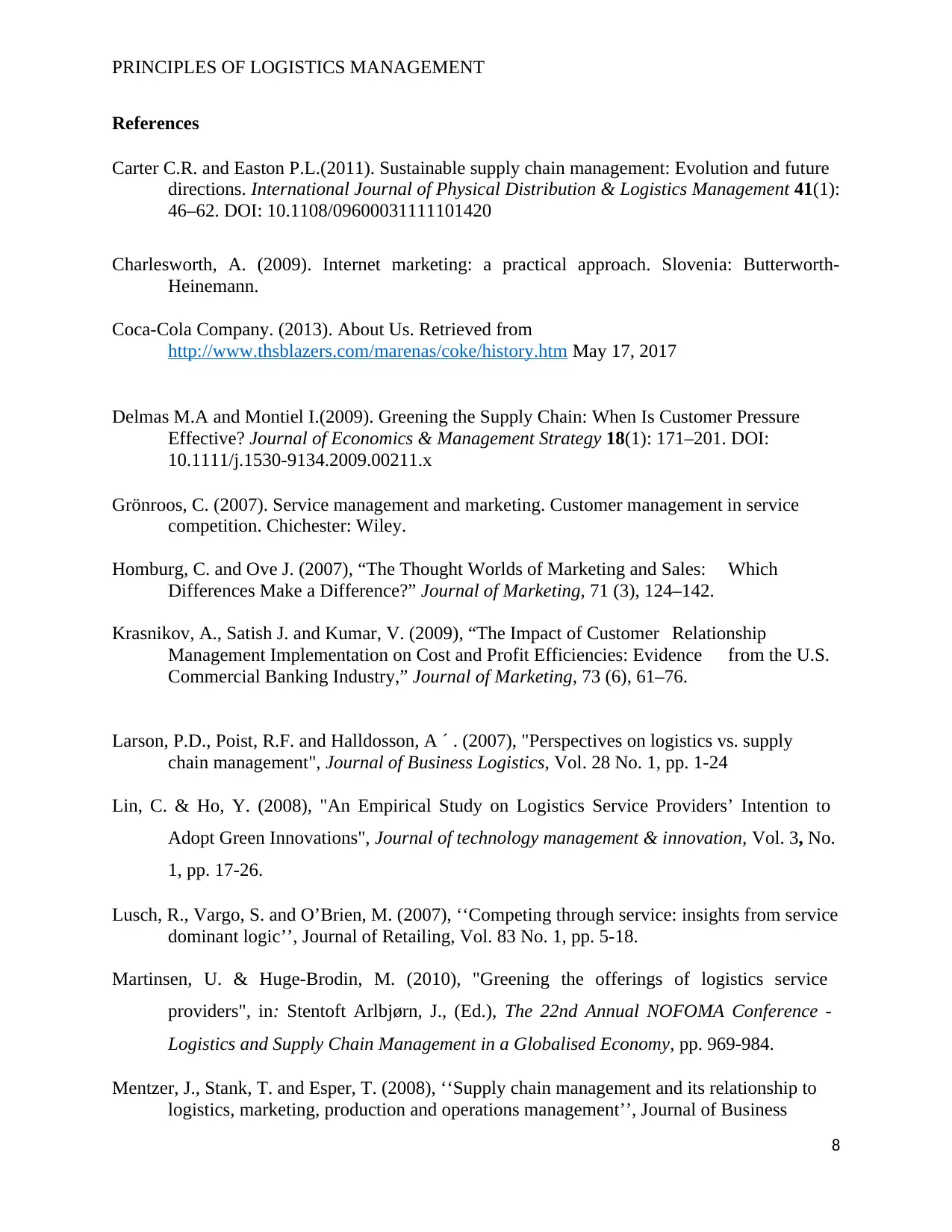
PRINCIPLES OF LOGISTICS MANAGEMENT
References
Carter C.R. and Easton P.L.(2011). Sustainable supply chain management: Evolution and future
directions. International Journal of Physical Distribution & Logistics Management 41(1):
46–62. DOI: 10.1108/09600031111101420
Charlesworth, A. (2009). Internet marketing: a practical approach. Slovenia: Butterworth-
Heinemann.
Coca-Cola Company. (2013). About Us. Retrieved from
http://www.thsblazers.com/marenas/coke/history.htm May 17, 2017
Delmas M.A and Montiel I.(2009). Greening the Supply Chain: When Is Customer Pressure
Effective? Journal of Economics & Management Strategy 18(1): 171–201. DOI:
10.1111/j.1530-9134.2009.00211.x
Grönroos, C. (2007). Service management and marketing. Customer management in service
competition. Chichester: Wiley.
Homburg, C. and Ove J. (2007), “The Thought Worlds of Marketing and Sales: Which
Differences Make a Difference?” Journal of Marketing, 71 (3), 124–142.
Krasnikov, A., Satish J. and Kumar, V. (2009), “The Impact of Customer Relationship
Management Implementation on Cost and Profit Efficiencies: Evidence from the U.S.
Commercial Banking Industry,” Journal of Marketing, 73 (6), 61–76.
Larson, P.D., Poist, R.F. and Halldosson, A ´ . (2007), "Perspectives on logistics vs. supply
chain management", Journal of Business Logistics, Vol. 28 No. 1, pp. 1-24
Lin, C. & Ho, Y. (2008), "An Empirical Study on Logistics Service Providers’ Intention to
Adopt Green Innovations", Journal of technology management & innovation, Vol. 3, No.
1, pp. 17-26.
Lusch, R., Vargo, S. and O’Brien, M. (2007), ‘‘Competing through service: insights from service
dominant logic’’, Journal of Retailing, Vol. 83 No. 1, pp. 5-18.
Martinsen, U. & Huge-Brodin, M. (2010), "Greening the offerings of logistics service
providers", in: Stentoft Arlbjørn, J., (Ed.), The 22nd Annual NOFOMA Conference -
Logistics and Supply Chain Management in a Globalised Economy, pp. 969-984.
Mentzer, J., Stank, T. and Esper, T. (2008), ‘‘Supply chain management and its relationship to
logistics, marketing, production and operations management’’, Journal of Business
8
References
Carter C.R. and Easton P.L.(2011). Sustainable supply chain management: Evolution and future
directions. International Journal of Physical Distribution & Logistics Management 41(1):
46–62. DOI: 10.1108/09600031111101420
Charlesworth, A. (2009). Internet marketing: a practical approach. Slovenia: Butterworth-
Heinemann.
Coca-Cola Company. (2013). About Us. Retrieved from
http://www.thsblazers.com/marenas/coke/history.htm May 17, 2017
Delmas M.A and Montiel I.(2009). Greening the Supply Chain: When Is Customer Pressure
Effective? Journal of Economics & Management Strategy 18(1): 171–201. DOI:
10.1111/j.1530-9134.2009.00211.x
Grönroos, C. (2007). Service management and marketing. Customer management in service
competition. Chichester: Wiley.
Homburg, C. and Ove J. (2007), “The Thought Worlds of Marketing and Sales: Which
Differences Make a Difference?” Journal of Marketing, 71 (3), 124–142.
Krasnikov, A., Satish J. and Kumar, V. (2009), “The Impact of Customer Relationship
Management Implementation on Cost and Profit Efficiencies: Evidence from the U.S.
Commercial Banking Industry,” Journal of Marketing, 73 (6), 61–76.
Larson, P.D., Poist, R.F. and Halldosson, A ´ . (2007), "Perspectives on logistics vs. supply
chain management", Journal of Business Logistics, Vol. 28 No. 1, pp. 1-24
Lin, C. & Ho, Y. (2008), "An Empirical Study on Logistics Service Providers’ Intention to
Adopt Green Innovations", Journal of technology management & innovation, Vol. 3, No.
1, pp. 17-26.
Lusch, R., Vargo, S. and O’Brien, M. (2007), ‘‘Competing through service: insights from service
dominant logic’’, Journal of Retailing, Vol. 83 No. 1, pp. 5-18.
Martinsen, U. & Huge-Brodin, M. (2010), "Greening the offerings of logistics service
providers", in: Stentoft Arlbjørn, J., (Ed.), The 22nd Annual NOFOMA Conference -
Logistics and Supply Chain Management in a Globalised Economy, pp. 969-984.
Mentzer, J., Stank, T. and Esper, T. (2008), ‘‘Supply chain management and its relationship to
logistics, marketing, production and operations management’’, Journal of Business
8
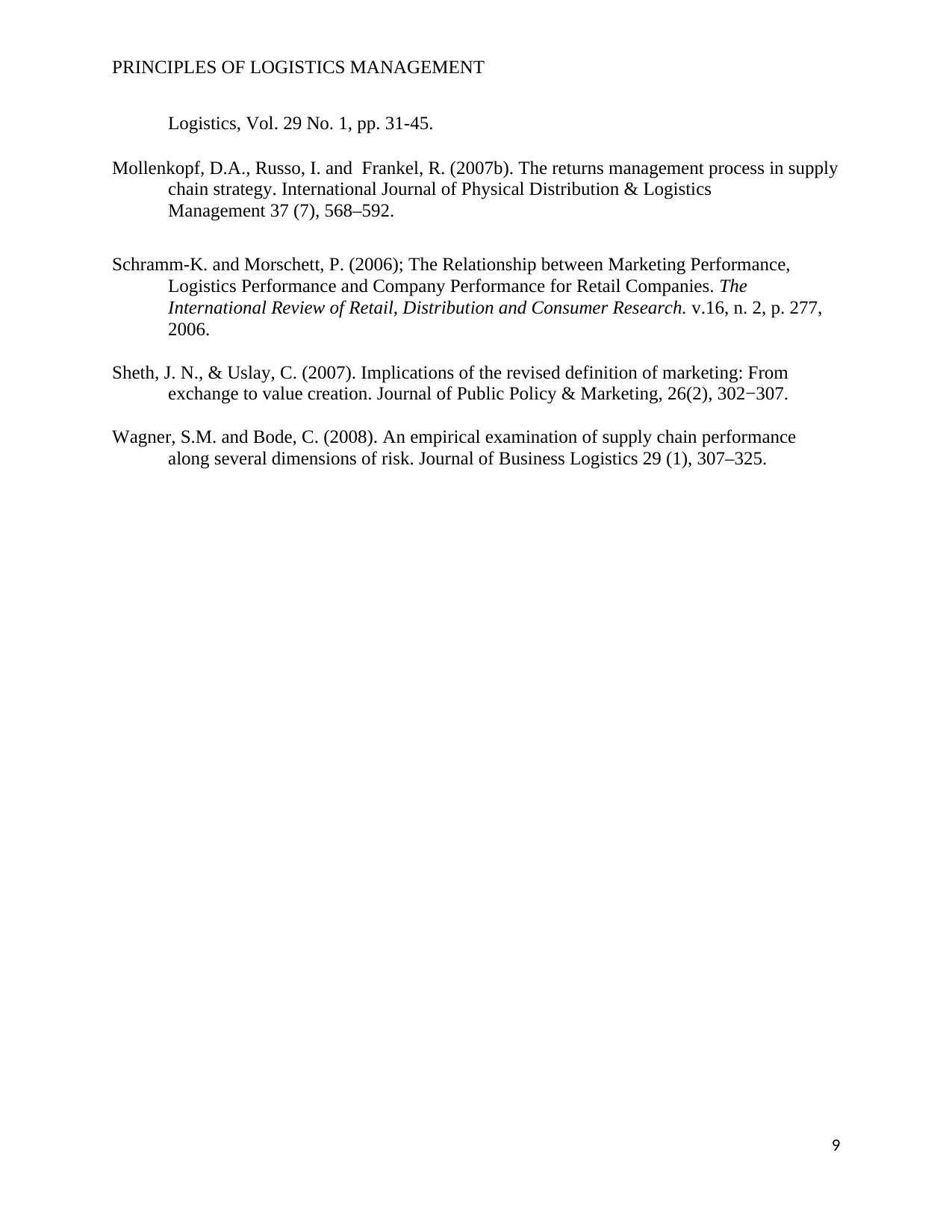
PRINCIPLES OF LOGISTICS MANAGEMENT
Logistics, Vol. 29 No. 1, pp. 31-45.
Mollenkopf, D.A., Russo, I. and Frankel, R. (2007b). The returns management process in supply
chain strategy. International Journal of Physical Distribution & Logistics
Management 37 (7), 568–592.
Schramm-K. and Morschett, P. (2006); The Relationship between Marketing Performance,
Logistics Performance and Company Performance for Retail Companies. The
International Review of Retail, Distribution and Consumer Research. v.16, n. 2, p. 277,
2006.
Sheth, J. N., & Uslay, C. (2007). Implications of the revised definition of marketing: From
exchange to value creation. Journal of Public Policy & Marketing, 26(2), 302−307.
Wagner, S.M. and Bode, C. (2008). An empirical examination of supply chain performance
along several dimensions of risk. Journal of Business Logistics 29 (1), 307–325.
9
Logistics, Vol. 29 No. 1, pp. 31-45.
Mollenkopf, D.A., Russo, I. and Frankel, R. (2007b). The returns management process in supply
chain strategy. International Journal of Physical Distribution & Logistics
Management 37 (7), 568–592.
Schramm-K. and Morschett, P. (2006); The Relationship between Marketing Performance,
Logistics Performance and Company Performance for Retail Companies. The
International Review of Retail, Distribution and Consumer Research. v.16, n. 2, p. 277,
2006.
Sheth, J. N., & Uslay, C. (2007). Implications of the revised definition of marketing: From
exchange to value creation. Journal of Public Policy & Marketing, 26(2), 302−307.
Wagner, S.M. and Bode, C. (2008). An empirical examination of supply chain performance
along several dimensions of risk. Journal of Business Logistics 29 (1), 307–325.
9
⊘ This is a preview!⊘
Do you want full access?
Subscribe today to unlock all pages.

Trusted by 1+ million students worldwide
1 out of 9
Related Documents
Your All-in-One AI-Powered Toolkit for Academic Success.
+13062052269
info@desklib.com
Available 24*7 on WhatsApp / Email
![[object Object]](/_next/static/media/star-bottom.7253800d.svg)
Unlock your academic potential
Copyright © 2020–2025 A2Z Services. All Rights Reserved. Developed and managed by ZUCOL.




